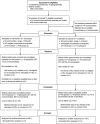An agriculture-nutrition intervention improved children's diet and growth in a randomized trial in Ghana
- PMID: 30332542
- PMCID: PMC6866204
- DOI: 10.1111/mcn.12677
An agriculture-nutrition intervention improved children's diet and growth in a randomized trial in Ghana
Abstract
Stunting in Ghana is associated with rural communities, poverty, and low education; integrated agricultural interventions can address the problem. This cluster randomized controlled trial tested the effect of a 12-month intervention (inputs and training for poultry farming and home gardening, and nutrition and health education) on child diet and nutritional status. Sixteen clusters were identified and randomly assigned to intervention or control; communities within clusters were randomly chosen, and all interested, eligible mother-child pairs were enrolled (intervention: 8 clusters, 19 communities, and 287 households; control: 8 clusters, 20 communities, and 213 households). Intention-to-treat analyses were used to estimate the effect of the intervention on endline minimum diet diversity (≥4 food groups), consumption of eggs, and length-for-age (LAZ)/height-for-age (HAZ), weight-for-age (WAZ), and weight-for-length (WLZ)/weight-for-height (WHZ) z-scores; standard errors were corrected for clustering. Children were 10.5 ± 5.2 months (range: 0-32) at baseline and 29.8 ± 5.4 months (range: 13-48) at endline. Compared with children in the control group, children in the intervention group met minimum diet diversity (adjusted odds ratio = 1.65, 95% CI [1.02, 2.69]) and a higher LAZ/HAZ (β = 0.22, 95% CI [0.09, 0.34]) and WAZ (β = 0.15, 95% CI [0.00, 0.30]). Sensitivity analyses with random-effects and mixed-effects models and as-treated analysis were consistent with the findings. There was no group difference in WLZ/WHZ. Integrated interventions that increase access to high-quality foods and nutrition education improve child nutrition.
Keywords: agriculture; dietary diversity; length-for-age; nutrition education; poultry; weight-for-age.
© 2018 John Wiley & Sons Ltd.
Conflict of interest statement
The authors declare that they have no conflicts of interest.
Figures
References
-
- Berti, P. R. , Krasevec, J. , & Fitzgerald, S. (2004). A review of the effectiveness of agriculture interventions in improving nutrition outcomes. Public Health Nutrition, 7, 599–609. - PubMed
-
- Brown, D. L. (2003). Solutions exist for constraints to household production and retention of animal food products. Journal of Nutrition, 133, 4042S–4047S. - PubMed
-
- Cameron, A. C. , & Miller, D. L. (2011). Robust inference with clustered data In Ullah A., & Giles D. E. A. (Eds.), Handbook of empirical economics and finance (pp. 1–28). Boca Raton: CRC Press.
-
- Cohen, J. (1977). Statistical power analysis for the behavioral sciences. New York: Academic Press.
-
- Food and Agriculture Organization . (2012). Escala Latinoamericana y Caribeña de seguridad alimentaria (ELCSA): Manual de uso y aplicaciones. Santiago, Chile, FAO Regional Office, Latin America. (http://www.rlc.fao.org/es/publicaciones/elcsa/).
Publication types
MeSH terms
LinkOut - more resources
Full Text Sources
Medical
Miscellaneous


